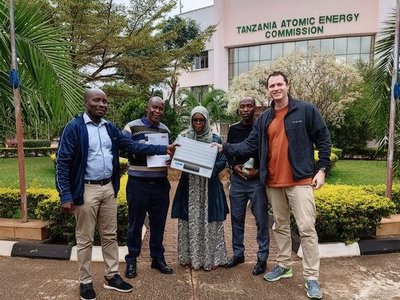

Phosphate rock, pre-concentrated phosphate ore, is the primary raw material for the production of mineral phosphate fertilizer that is responsible for global food production as we know it today. Phosphate rock is among the fifth most mined materials on earth, and it is also mined and processed to fertilizers in East Africa. Phosphate ore can contain relevant heavy metal impurities such as toxic cadmium and radiotoxic uranium. In addition, valuable trace elements such as rare earths can be present in elevate concentrations. Prolonged use of phosphate rock powder as a fertilizer and application of mineral fertilizers derived from phosphate rock on agricultural soils can lead to an accumulation of heavy metals that can then pose an environmental risk. There is presently an active scientific debate about the risks of uranium in phosphate fertilizers and the potential environmental risk of long-term dissipation of this radiotoxic heavy metal on agricultural soils. This joint KoEF project, conducted between the University for Continuing Education Krems (UWK, formerly Danube University Krems) from Austria and the Tanzania Atomic Energy Commission (TAEC) from the United Republic of Tanzania, assesses the environmental risks associated with uranium in phosphate rocks and fertilizers originating from East Africa. Particularly, Minjingu phosphate rock is known to have relatively high uranium concentrations of up to 600 ppm, that exceed those of most phosphate rocks (usually sedimentary phosphate rocks show uranium concentrations of 80-180 ppm). To put this into perspective it is worth noting that Namibia is commercially mining uranium from ores with average grades of 150-200 ppm. The 3-year project “Rethinking Minjingu Phosphate Rock” (KoEF 04/2019) investigated in a first step the average uranium concentrations of various phosphate rocks and phosphate fertilizers actively used in East Africa. Results have been published Open Access in Environmental Science and Pollution Research.
In a next step the project we investigated the uptake of uranium from fertilizers by tobacco plants in Tanzania. Tobacco is known to be a hyperaccumulator of uranium that is sometimes used to clean soils that experienced heavy metal pollution. It was thus interesting to compare the heavy metal content in tobacco plants from Tanzania with the heavy metal content of other tobacco plants that used fertilizers with reduced uranium content.
Besides, the project team is investigating alternative processes for fertilizer production in East Africa that would reduce the uranium content in the final fertilizer products. The raw materials in East Africa make for excellent fertilizers as they show elevated P2O5 contents (>30%) that is the main criteria for phosphate fertilizers. In addition, the fertilizers from domestic raw materials are much cheaper than imported fertilizers. Alternative processes do not only have to produce cleaner fertilizers, but most importantly be able to produce inexpensive fertilizers that can commercially compete with the current products. Otherwise, the new fertilizer products will simply not be used.
